BIOGRAPHY
Tazio Giorgio Nuvolari was born in Castel d'Ario (Mantova) on November 16, 1892, and went down in history as one of the greatest drivers of all times. He started racing in 1920 alternating motorcycles and cars. He would excel with both.
During his motorcycle years, Nuvolari obtained 69 victories (36 outright and 33 class wins), the 1924 European Championship, both 1924 and 1926 Italian Championships and three International Speed records. On no less than eight occasions, whilst riding a Bianchi 350, with which he was so successful, he managed to beat all the other riders driving 500 cc. bikes.
Achieving success in car racing required from him devoting time and perseverance. After having won some races as a privateer, he got an Alfa Romeo works car for the 1930 Mille Miglia. He dominated the race at a record average speed of over 100-kph.
During the 1930's he became an outstanding star of road and track racing in Europe, Africa and America, driving mainly Scuderia Ferrari's Alfa Romeos, Maseratis and Auto Unions.
After the Second World War, despite his age and declining health, with his soul devastated by the death nine years apart of his two sons, Giorgio and Alberto (both eighteen), he still won some races and was the leading force in two other that he did not win but dominated extensively, the 1947 and 1948 editions of the Mille Miglia.
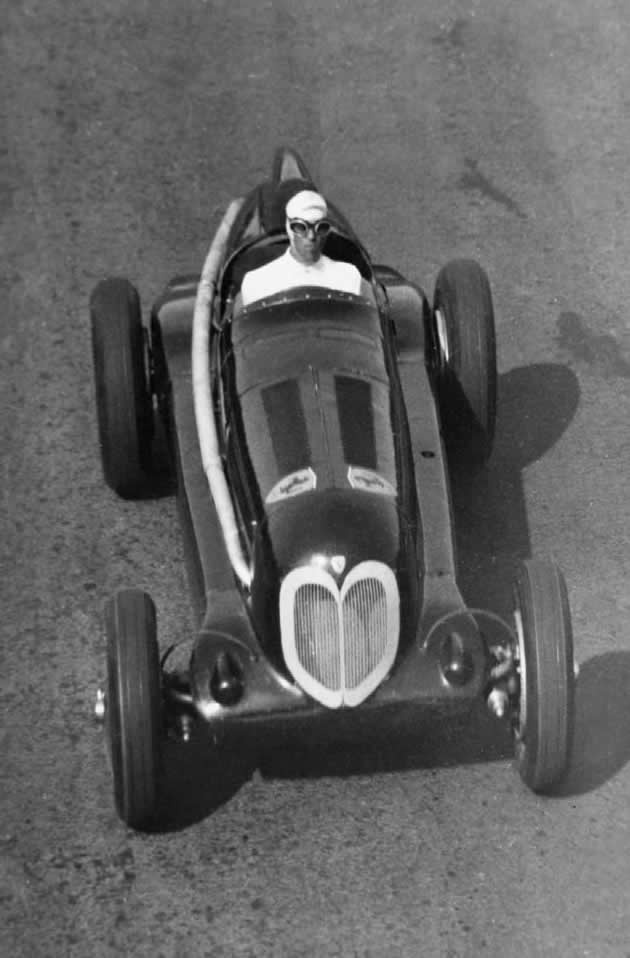
His racing record driving cars includes 92 wins (55 outright, 37 class), the European Championship in 1932, three Italian Championships (1932, 1935, 1936) and two International Speed records. In total, he recorded the fastest lap of a race no less than 101 times (42 in motorcycles, 59 whilst driving a racing car).
Whilst he survived a series of horrific accidents during his career, he died on 11 August 1953 in his bed at home in Mantua, victim of a heart attack. He was still a very popular figure.
Ferdinand Porsche named him «the greatest driver of the past, present and future».
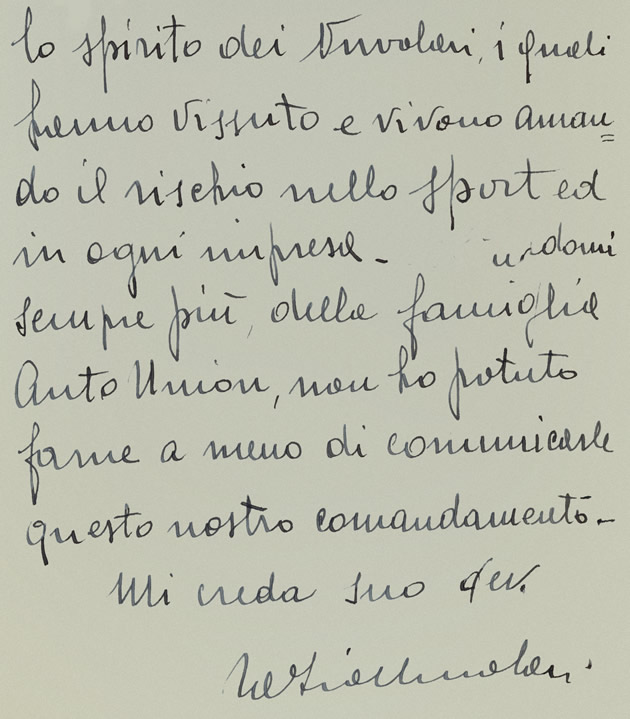
Tazio Nuvolari
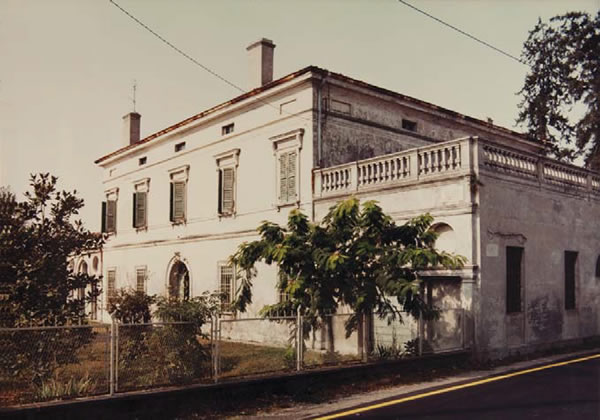
Castel d'Ario (Mantua). The house in which Nuvolari was born, on 16 November 1892
Tazio Giorgio Nuvolari was born in Castel d'Ario, not far from Mantua, on the 16th November 1892 at 9 in the morning. Tazio was the fourth son of Arturo Nuvolari (1863-1938, a well off farmer) and his wife Elisa Zorzi (1864-1943, a housewife from Trento).Tazio was a very lively and active boy.
He didn't like studying: sports were more interesting for him. His father was a quite good cyclist, while his brother Giuseppe was a champion: the latter won the Italian National Championship several times, scoring some success even abroad in the speed track and in the very first races behind motorcycles. The young Tazio had always felt a great admiration for his uncle, always trying to imitate him.
The speed
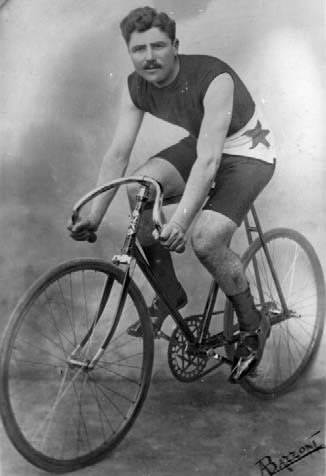
Giuseppe Nuvolari (1871-1962), champion racing cyclist, little Tazio's uncle and idol.
On the 5th of September 1904, Tazio saw for the first time a car race: the Circuit of Brescia. He was favourably impressed by the speed and by the ace drivers of that time: Vincenzo Lancia, Nazzaro, Cagno, Hémery, DurayIn 1904 and 1905 two episodes were very important and left a mark on his personality. First of all, one day his uncle Giuseppe tought him to drive a motorcycle. And then, one night Tazio stole his father's car and drove it in the moonlight. Later he said: «I was about 13. How fast was I driving? About 30 KpH, no more...».
«You are not cut out for this job»
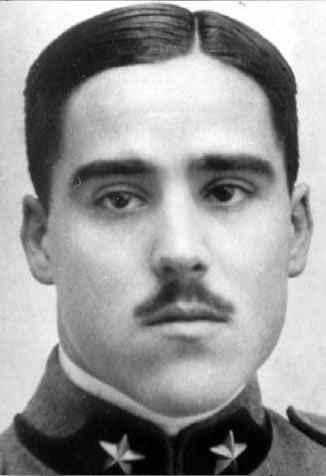
Nuvolari in military uniform as a national serviceman (1913-1914).
His great passion for motorcycles and cars, and his competitive spirit were growing faster and faster. Photos have been found with Tazio standing tall on a motorcycle driving fast along a dusty road, or wearing bonnet and goggles at the wheel of a Scat - a car he never drove during a race, as far as we know.Tazio got the motorcycle race licence in 1915, when he was 23. However, a few months later the war broke out and he was in the Army as driver. He drove Red Cross ambulances, lorries and car with the Officers. One day, while he was
driving, he got out of the road. The Official with him said «Listen to me: forget driving. You are not cut out for this job».
The wedding
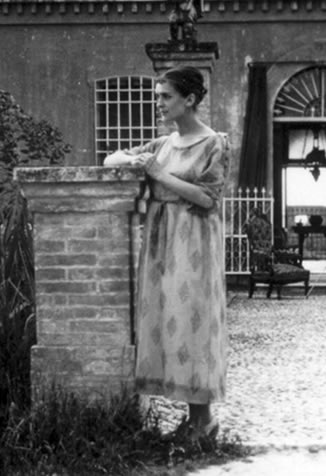
In 1917 Nuvolari married Carolina Perina (1894-1981), from Castel d'Ario as him, here portrayed by Tazio himself in 1918, when pregnant with the couple's first child Giorgio.
On November 10th, 1917, Tazio married Carolina Perina (1894-1981) in Milan, with a civil ceremony. On September 4th, 1918, their first child Giorgio was born.The first races
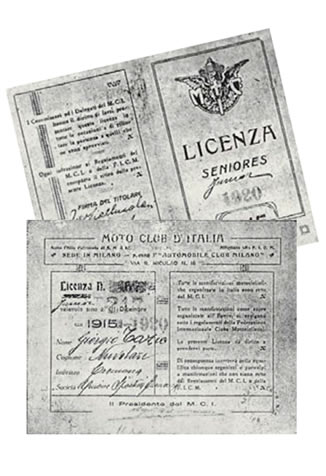
Nuvolari's got first motorcycle racing licence in 1920. He entered his début race in Cremona using his second name of Giorgio
His first race was on the 20th of June 1920, at the Circuito Internazionale Motoristico (International Motorcyclist Circuit) in Cremona. He entered the competition with his second name - Giorgio - riding a Della Ferrari. He was forced to retire.On March 20th, 1921, he drove an Ansaldo tipo 4 in his first car race: a reliability trial («Coppa veronese di regolarità») that he finished first.
During 1922 Tazio moved from Castel d'Ario to Mantua. He started three competitions by motorcycle and one by car: the Circuito del Garda (Garda Meeting) in Salò, where driving an Ansaldo he finished second overall.
Professional pilot
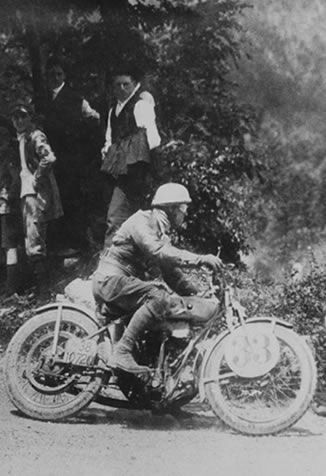
Lario Circuit, 29 June 1924. Tazio in action riding his Bianchi 350 «Freccia Celeste»
In 1923, the 31 year old Nuvolari made racing - as well as being his overriding passion - his own business.Competing mainly on two wheels, he did not take long to be among the leaders. With motorcycles he gained
many wins, being less fortunate with the cars. He raced with the Diatto but got along better with the little «Chiribiri tipo Monza».
1925: motorcycles above all
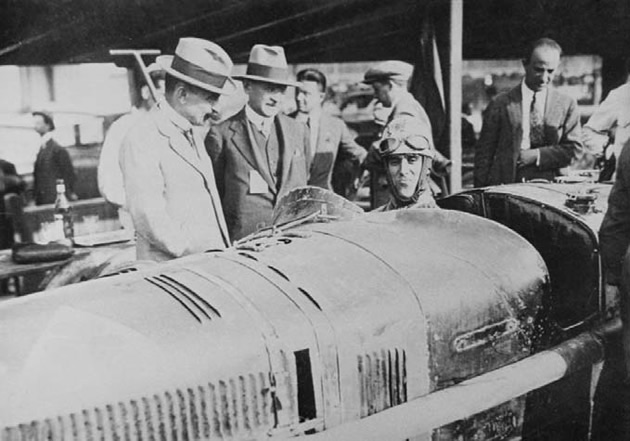
Monza, 1 settembre 1925. Nuvolari accanto all'ingegnere Nicola Romeo, in attesa di provare la "grand prix" Alfa Romeo P2
In 1925 Nuvolari did not race car at all.These were the years of his consecration as an ace of the two wheelers. However, summoned for a test drive on Sept. 1st, 1925, at Monza, he was given the triumphant P2 - the dominat Gran prix car of those days - to drive. He drove
faster and faster for 5 laps - faster than Campari and Marinoni, and close to Antonio Ascari's best lap of the year before. But at the sixth lap, his test drive ended with a spectacular unplanned exit from the track (Nuvolari could have taken the place of Ascari, who was killed at Monthléry a month before; but Vittorio Jano, the Alfa Romeo director racing, would not consider him again until 1929). The car was heavily damaged, the driver injured but 12 days later Tazio, still aching, went to Monza where, with a special bandage, he rode his Bianchi 350 and won the Gran Premio delle Nazioni.
The freccia celeste
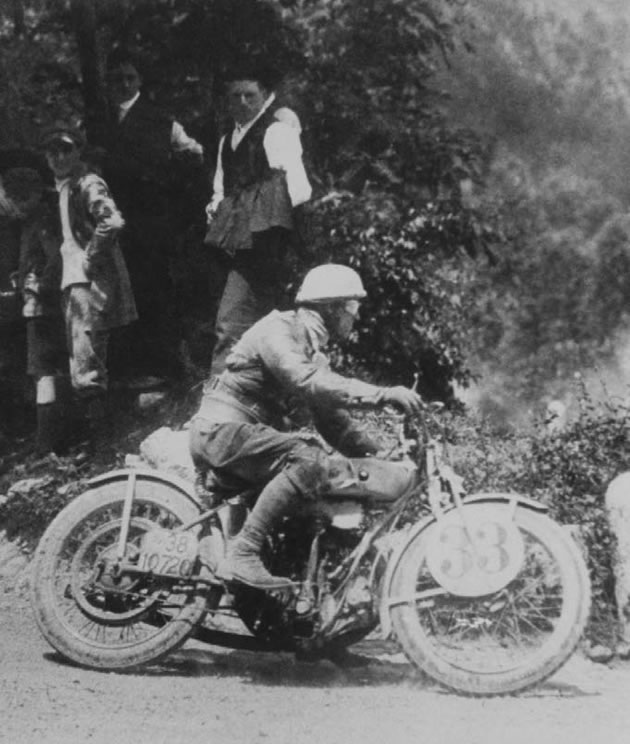
Lario Circuit, 29 June 1924. Tazio in action riding his Bianchi 350 «Freccia Celeste»
1926 Tazio was still racing with his Bianchi 350, the legendary «Freccia Celeste» (light blue arrow) and won all major competitions. He had three serious accidents, the first of these on the Solitude Circuit near Stuttgart. He came off the track because of the fog, and was really bad injured. The day after he felt better and left by train to come back to Italy. While crossing the border, he met one of the members of Bianchi team who was going to Stuttgart to see what was happened: the Italian consul, in fact, had sent to Rome a very concerned telegram. Moreover, a German journalist had written about Tazio's death on an evening newspaper.He was very popular; they called him the «two wheeler Campionissimo» but he still loved cars.
In 1927, at the wheel of a Bianchi tipo 20, he took part in the first Mille Miglia, finishing tenth overall. But the best results of the season were obtained with his own Bugatti 35, gaining two absolute and convincing wins in the «Gran Premio Reale» di Roma and the «Circuito del Garda».
The Scuderia Nuvolari
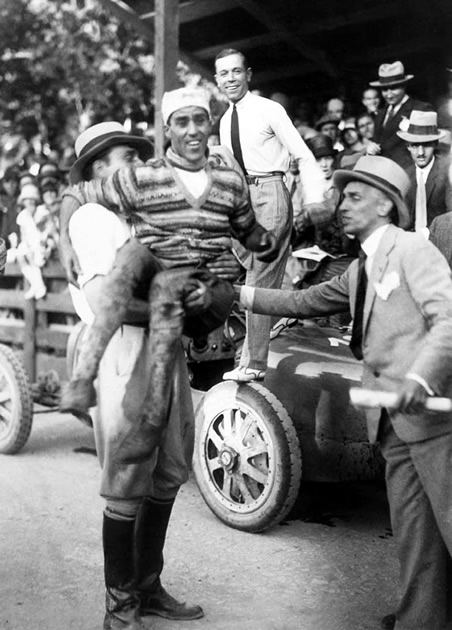
11 March 1928. First international victory for Nuvolari, over Bugatti, in the Tripoli GP
Between 1927 and 1928 Tazio made his choice: in order to intensify his own activity as a car driver, he started his own racing team in Mantua. He bought four Bugatti Grand Prix, and then resold two of them to Achille Varzi (Tazio's tough rival; but also one of his best friends) and to Cesare Pastore. The Scuderia Nuvolari's debut, on March 11th, was a triumph: nine days after his second son's birth, Alberto, Tazio won the Gran Prix of Tripoli, scoring his first big international victory. He won also the «Circuito del Pozzo» in Verona, beating the great Pietro Bordino who was to die in an accident shortly afterwwards, during a practice to race the Circuito di Alessandria. So Nuvolari took part in the Circuito di Alessandria - dedicatedto the memory of Bordino - honouring the died champion with a great win.
The breaking off with Achille Varzi
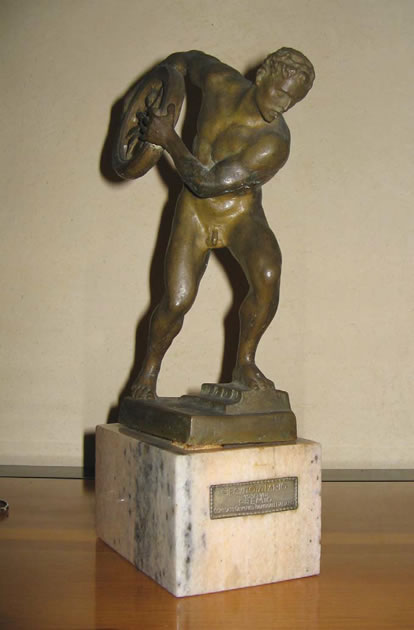
The 1930 trophy of Lario Circuit, where Tazio riding a 350 cc Bianchi beat all the 500s.
1929 was one of the most difficult years in Nuvolari's life and career. He managed himself his competitive activities, and this was very expensive. The agreement he had with Varzi failed soon afterwards, as two cocks couldn't stay in the same poultry pen. He tried to do his own best, alternating car/motorcycle racing and sporting activities with being a car dealer for Bianchi, Scat, Alfa Romeo and Lancia. He often raced with different cars (Bugatti 35C, OM 665 Speciale, Alfa Romeo 6C 1750SS, Talbot 1500...) but he had such few success.For Tazio, the 1929 was to be considered a year to forget.
1930, the turning point
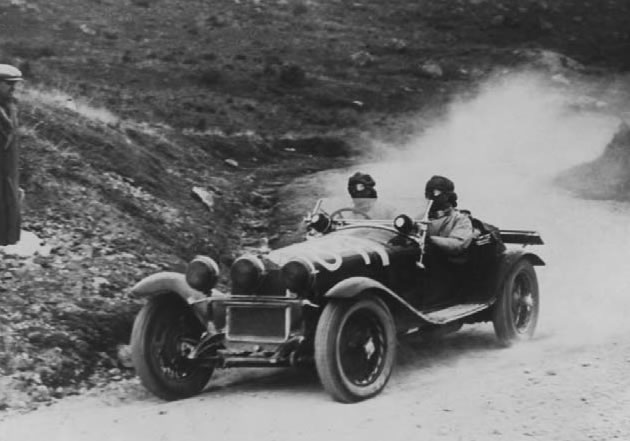
Mille Miglia 1930. Nuvolari is the first to exceed an average speed of 100 km/h.
The turning point dates back from 1930. After the failure in Monza, the Alfa Romeo had not taken Tazio into consideration anymore, but Vittorio Jano had not forgotten about him. Hewanted Nuvolari in the Alfa Romeo team and wrote a memorable letter to him.Tazio signed the contract and was soon summoned for testing. The official debut could not have been
more exciting: Nuvolari at the wheel of the Alfa Romeo 6C 1750 won the 4th Mille Miglia in a record time. He was the first driver to complete the long and extremely difficult route at an
average speed of over 100 KpH. This fact made him immensely popular. The race is remembered for a curious event which is still under discussion: after a strong long distance duel with Varzi, Nuvolari managed to overtake him driving with lights turned off for the last kilometers. His coéquipier G. B. Guidotti, indifferent of all the objections (first of all, that the overtaking took place in the daylight), told in many interviews it was himself to switch the lights off.
The Scuderia Ferrari and Tazio's farewell to motorcycle racing
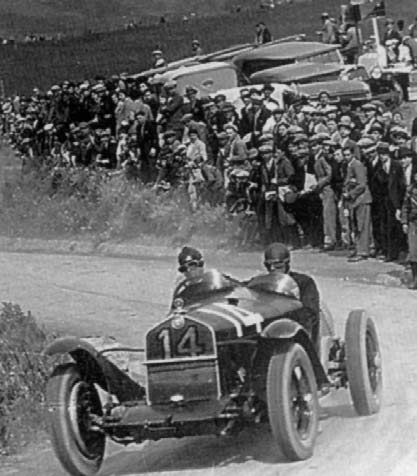
110 May 1931. Nuvolari on the Sicilian Madonie circuit, drives his Alfa Romeo 8C2300 to score the first of his two wins in a row in the classic Targa Florio race
In 1930 Nuvolari raced even more often, alternating tracks and road competition; especially hill climb.At the Trieste - Opicina he gave the new born Scuderia Ferrari their first win, and soon became their standard bearer. He also won the Cuneo-Colle della Maddalena, the «Vittorio Veneto-Cansiglio» and the Tourist Trophy run at the Ards Circuit near Belfast. During 1930 Nuvolari retired from motorcycle racing, activity in which he had excelled for a long time, with four final exploits: among them the Lario Trophy, where he was first overall, first in class, and drove the fastest lap. His 350CC Bianchi crossed the finishing line before all the 500CC motorcycles.
1931 was one of the most active years for Nuvolari. He drove for 20 races with at least 3 major victories out of a total of 7: the Targa Florio, the Italian Grand Prix and the Coppa Ciano. He raced the Reale Gran Premio di Roma with an old Bugatti 35C, driving all the other races with the Alfa Romeo cars of Scuderia Nuvolari: the 6CC 1500SS, the Tipo A monoposto and above all the 8C 2300 - versions «Passo corto» and Monza.
1932: a successful season

1932 was a triumphal year: Nuvolari in the Alfa Romeo 8C2300 won the Monaco GP at Monte Carlo
By this time Nuvolari's star (the «Flying Mantuan», as he was called) blazed in the racing world. Out of 16 races, Tazio won 7: the Gran Prix of Monaco, the Targa Florio, the Italian Grand Prix, the French Grand prix, the Circuito di Avellino, the Coppa Ciano and the Coppa Acerbo.There were also 5 first in class and 9 fastest laps. The only race he did not managed to finish was the Mille Miglia:
coming out Florence, his car run out of the road. Nuvolari's triumphal year was made complete by two other titles of great prestige: the Italian driver's championship and the International
Championship, won on the basis of the three victories in the Grand Prix races of Italy, France, Germany.
D'Annunzio and the turtle
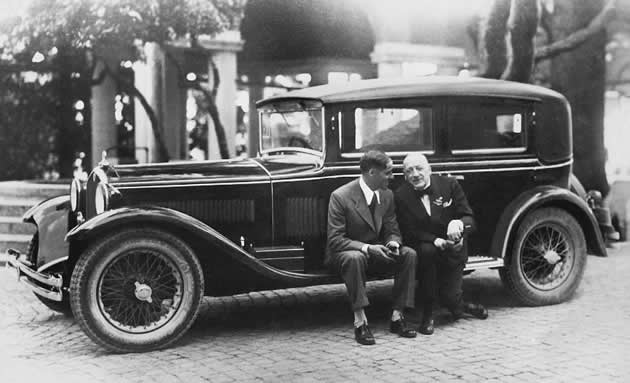
Nuvolari's popolarity grew more and more. On 28 April 1932, famous Italian poet and writer Gabriele D'Annunzio, who admired him as a heroe, invited him to the "Vittoriale", his fantastic residence on Garda Lake
Nuvolari's name was frequently seen on the front page. He found himself invited by many of the «Greats» of the time. The poet Gabriele D'Annunzio received him at The Vittoriale degliItaliani, where Nuvolari was given a little golden turtle bearing the dedication: «To the fastest man in the world, the slowest animal». Tazio considered this little piece as a good luck charm, and also a symbol. He had it embroidered on the yellow jersey which he wore to race in, printed on his stationery and painted on the side of the personal airplane that he acquired some years later. He had also some copies made which - just as the poet had done - he gave to friends, those dear to him and also those who could be important.
A few months later, just after Tazio's win in the Coppa Acerbo, Mussolini received him in Rome and posed with him for the photographers by an Alfa Romeo P3.
The divorce from Ferrari
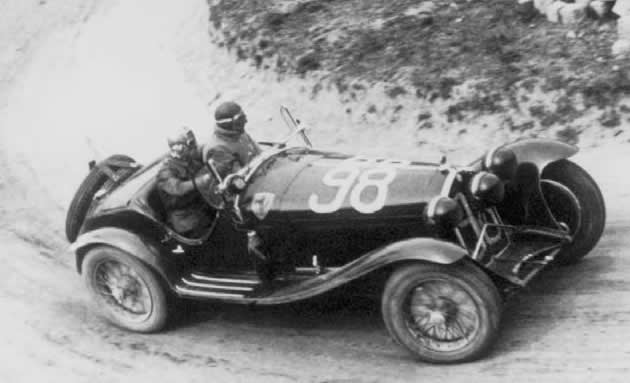
8-9 April 1933. A second victory for Nuvolari in the Mille Miglia, this time driving an Alfa Romeo 8C2300 MM. Next to Tazio, his mechanic and personal friend Decimo Compagnoni.
In 1933 Nuvolari won 11 races. On the racing side this was certainly a positive season, but otherwise it was characterized by disagreements and tension. Tazio won the Tunisian Gran Prix, the Mille Miglia, the Circuit of Alessandria, the Eifelrennen, the Grand Prix of Nimes and the 24 Hours of Le Mans; but then he decided to divorce from the Scuderia Ferrari. Tazio was led to this move by being convinced that, by going it alone, he could get better cars and make more money, too.At the start of the Belgium Grand Prix, he appeared with a Maserati 8CM prepared by his personal mechanic Decimo Compagnoni. He won in Belgium, in the Coppa Ciano and in the
Grand Prix of Nice, ending the season on the Spanish track in San Sebastian, where he had a serious accident.
In 1933 he drove 5 different cars: Alfa Romeo 8C 2300 Spyder (Passo Corto), Alfa Romeo 8C 2300 Le Mans, 8C 2600 Monza, Maserati 8CM.
He had also a MG Magnette K3 for the Tourist Trophy where Nuvolari was, of course, first overall.
The peace with Enzo Ferrari
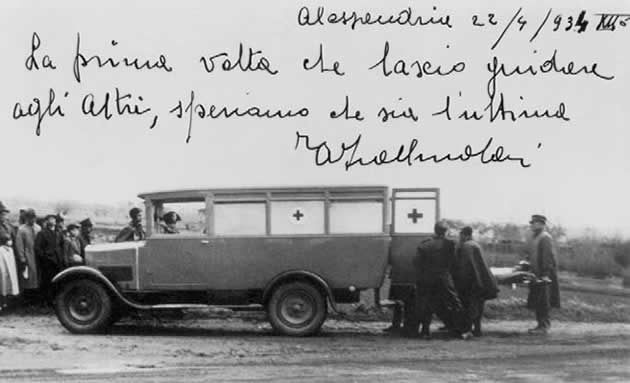
Tazio soon recovered and invented ironic comments for photos in which he appeared.
At the end of 1934 Nuvolari entered into negotiations with Auto Union. It is known that in September Tazio had a double test drive with the 16C Tipo A rear engine: the first test at the Grand Prix in Spain, on the Lasarte Circuit in San Sebastian; the second in Brno, at the Masaryk Circuit. However, some pilots of the Auto Union (maybe Stuck) opposed to the signing up of Tazio. The engagement was broken, and the «wedding» put off: the Auto Union engaged Achille Varzi.So «the flying Mantuan» signed the peace with Enzo Ferrari, and in 1935 Tazio was back in the Scuderia Ferrari.
He soon began again to win: in the first race of the season (at Pau, on an Alfa Romeo Tipo B called P3), and again in Bergamo, Biella and Turin with a more powerful and modified model P3 of the Scuderia Ferrari.
1935: the «impossible win» at Nürburgring
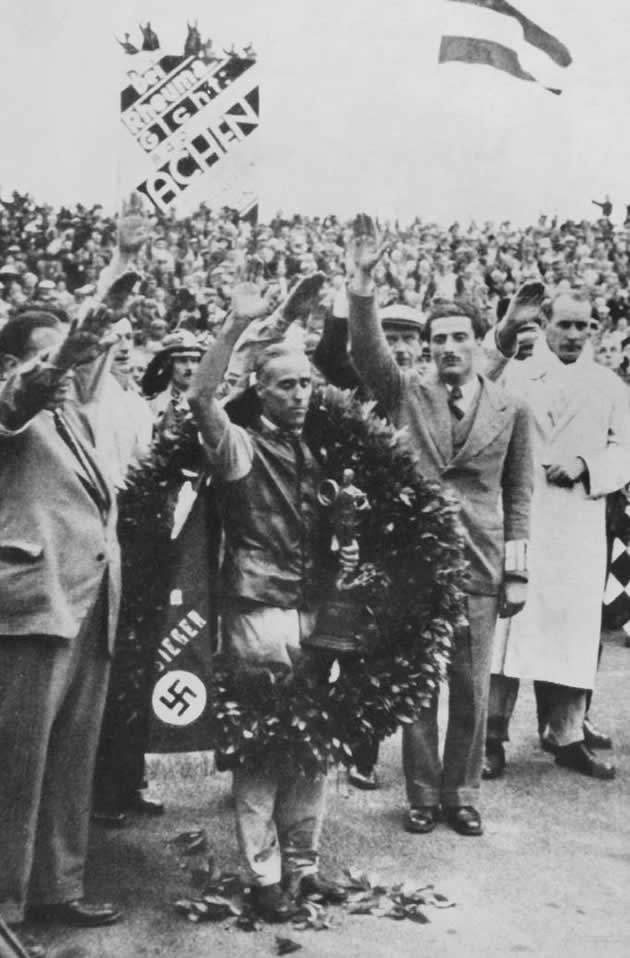
Nürburgring, 28 July 1935. Nuvolari after the "mpossible win" in the German Grand Prix.
His most impressive performance was the «impossible victory» in the German Grand Prix at Nürburgring, driving the obsolete Alfa Romeo P3 (3167cm3, compressor, 265HP) versus the ultimate home-teams cars: five Mercedes Benz W25 (3990 cm3, 8C, compressor, 375HP) and four Auto Union Tipo B (4950 cm3, 16C, compressor, 375HP).Tazio knocked everybody out, scoring maybe his most emblematic, epic win.
The record along Firenze-Mare
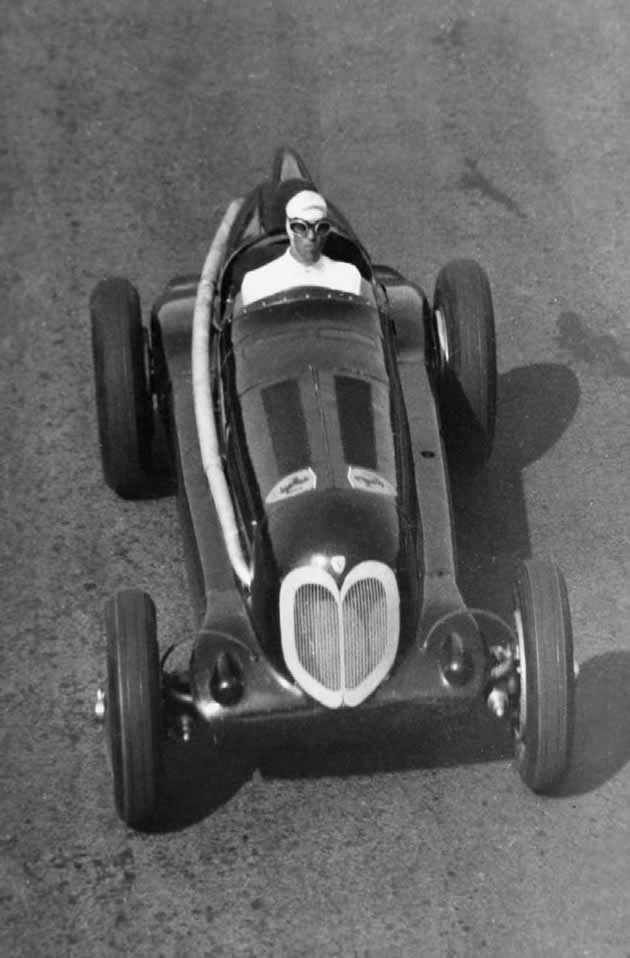
15 June 1935. Nuvolari, in the Alfa Romeo Bimotore, set up two new international record
Before the season ending, he won three more times: the Coppa Ciano, the Grand Prix of Nice and the one at Modena. On June 15th, he set two new international records over the kilometer and the flying mile (timing 321,426 and 323,125 KpH - and touching 336,252 KpH). The car was an Alfa Romeo bimotore, mounting two supercharged propellers (the 8C of theP3, one in the front and the other on the rear). They were 3165 cm3 each, for a total power of 6330 cm3 and a maximum strength of 540HP (270 x 2).
In the Italian Gran Prix, Nuvolari started with the new Alfa 8C-35 monoposto (single-seater) with whom he won, later, the Modena Circuit.
The Vanderbilt Cup
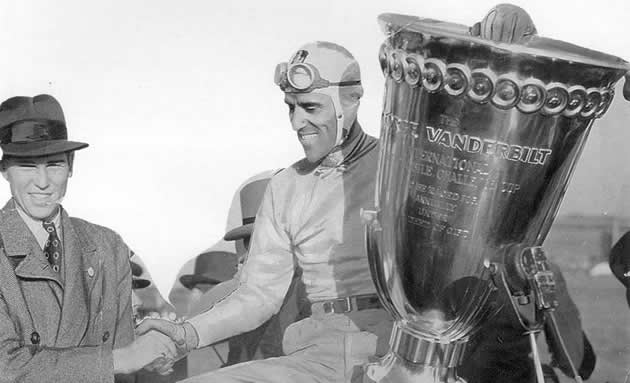
New York, 12 October 1936. Nuvolari won the prestigious George Vanderbilt Cup.
Nuvolari started the racing season occurring in another accident on May 8th, practicing for the Tripoli Gran Prix.Again he was thrown from the car sustaining multiple contusions and also appearantly cracking a couple of vertebrae. However the next day, although limping heavily, he returned to
the track and in a tremendous pain managed to finish eight. On June 7th he beat the German cars in Barcelona, on the 21st in Budapest, on the 28th in Milan, where he was first once more on the Alfa Romeo 12C, beating Achille Varzi's Auto Union. He sent the crowd wild with other two wins (the Coppa Ciano and the Modena Circuit) and finally he conquered the Americas with a runaway win in the Vanderbilt Cup. He drove two Alfa Romeo: the 8C-35 and the 12C-36.
1937, a bad year
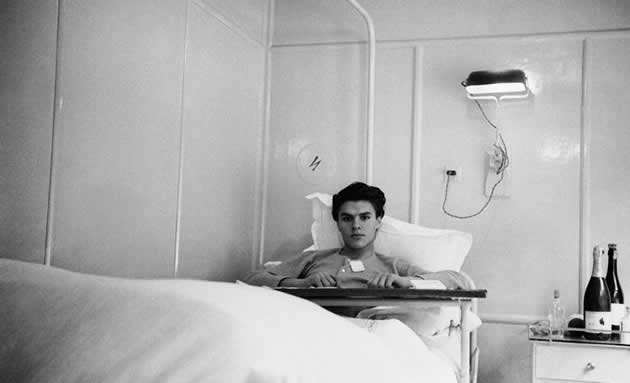
On June 27, 1937 Tazio was struck by mourning for the death of his eldest son Giorgio at 19
1937: the German cars dominated all the races, so it was a bad year for all the other drivers. Above all, Nuvolari had a death in his family: on June 27th, while Tazio was going overseas for the Valderbilt Cup on board of «the Normandie», he received a telegram from Mantua telling him of the death of his elder son, Giorgio, from myocarditis. The boy would have been 19 in September; the successof the previous year seemed gone far away. During the race, moreover, the Alfa Romeo driven by Tazio caught fire and the driver once more had to remove himself from the car in haste.
He had another accident (during the test of the Turin circuit), few races (9 alltogether) and only one win: at the Grand Prix in Milan. The 370CV of his 12C-36 were not enough in comparison with the 520CV 6 litres, 16C of the Auto Union Tipo C, and even less in comparison with the 646CV 5.6 litres 8C of the Mercedes Benz W125.
The Auto union and Tazio's coming back to race
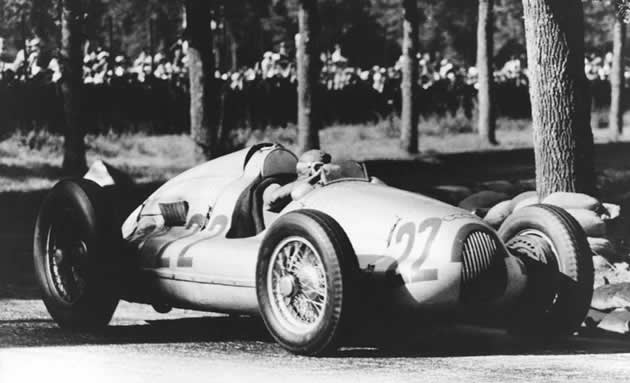
Monza, 11 September 1938. Nuvolari in Auto Union D absolute ruler of the Italian GP.
In 1938 the season opened with a new formula for Gran Prix cars (3000 cm3 limit powered for boasted engine, and 4500 for the sucked-up ones) but the arrangement did not change at all: the Alfa Romeo had on the track the new 308 (2991cm3, 8C compressor, 295CV, 260KpH) but the Mercedes Benz replied with the W154 (2962 cm3, 12C compressor, 468CV, 300 KpH).During practice for the Grand Prix of Pau the Alfa Romeo caught fire.
Tazio was bruised and suffered a few slight burns on his face, arms and legs.
He was more than anything severely shocked and had a long hard think.
He decided to retirefrom racing, but soon he rethought his decision.
He then left for a trip to the Unites States: he went to Indianapolis where he tried - wearing shirt and tie, and a borrowed helmet - a couple of single seaters without any satisfaction.
On his return to Europe he signed with Auto Union. They were looking for a pilot who yook the place of the young ace Bernard Rosemeyer, died on January 28th while attempting a record on the Frankfurt-Darmstadt motorway.
After three test drives, he drove the rear engined silver single seater Tipo D to two memorable victories: the Italian Grand prix in Monza and, two weeks later, the Grand Prix at Donington where he threw the Englishmen into ecstasies.
The war and the last race of Auto Union
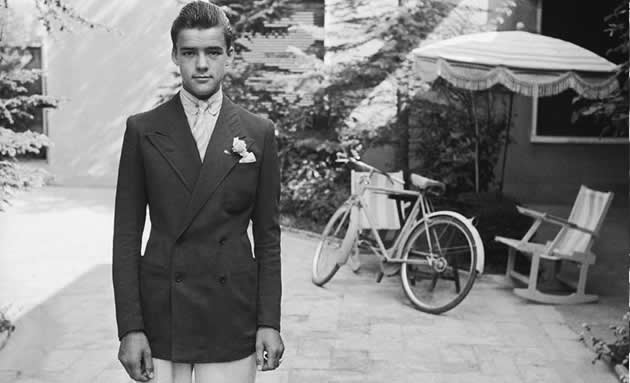
Nine years after Giorgio's death, Nuvolari lost also his second son Alberto, at the age of 18
The racing calendar shortened down as threats of war increased. The II World War had already broken out when the Grand Prix of Belgrade was run on the 3rd of September. It was the last success and the last race of Auto Union.Nuvolari won, ending an extraordinary era which found him as a legendary protagonist. In 1946 Nuvolari suffered another
personal tragedy: on the 11th of April his second son died, aged only 18.
Somehow he found the strength to start racing again. On the 12th of May he raced at the Grand Prix of Marseilles.
He showed that he was anything but past history, doing the fastest lap before his engine let him down. He would race anywhere, anyhow he could to survive his great pain.
«Without steering wheel»
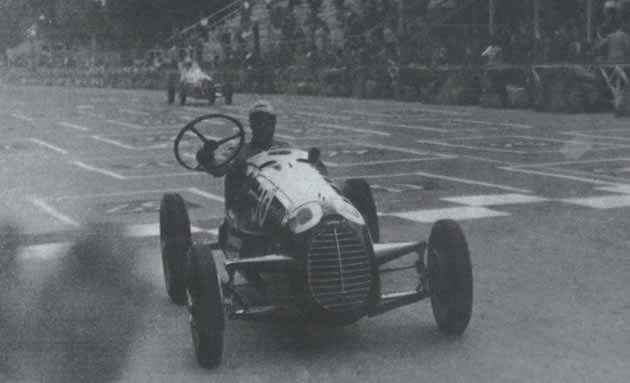
Torino, 3 September 1946. Tazio lost the wheel and drove holding the stump left on the column
He did not win as often as before, but he became more and more popular. In Turin, on September 3rd, he started the Coppa Brezzi driving a Cisitalia D46.He was in the lead at the end of the first lap. On the second one he passed in front of the pit area waving the steering wheel which had come off in his hands. He did another lap driving the steering column but then he had to stop for the inevitable repairs.
He started again and ended the race ranking 13th.
The story went around the world and added popularity to his already formidable myth.
The last victories
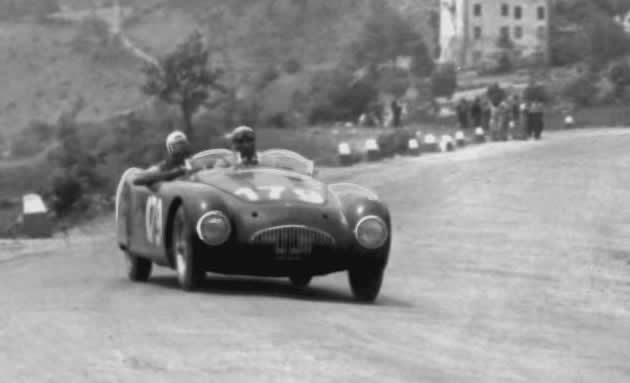
22 June 1947, Mille Miglia: only a cloudburst deprived Nuvolari of an amazing victory
In 1946 Tazio drove in 19 races, gaining three overall wins. Still with the Maserati, he got at Albi what was to be his last international triumph.Among the car he drove, we can count the Maserati 4CL, Fiat 1100S, and Cisitalia D46.
Aged 56, his last feat
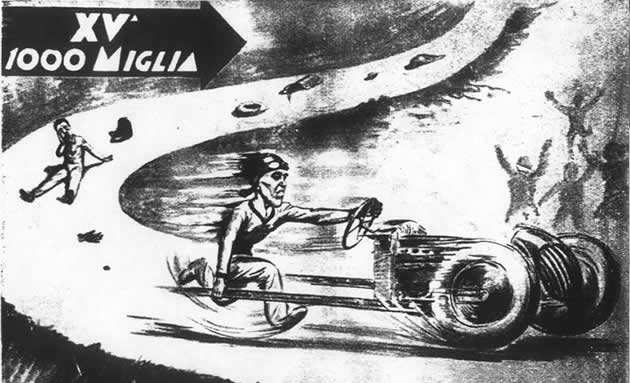
A cartoon inspired by Nuvolari and his unfortunate 1948 Mille Miglia with Ferrari.
In 1948 he drove in 5 races, finishing fourth in one, 7th in another and not classified in the rest. However one of these retirements - the XV Mille Miglia - was what many considered to have been his last great drive. The Cisitalia which was especially prepared for him broke during testing and could not be repaired in time. It seemed impossible that Nuvolari could do the race, but the day before the start Enzo Ferrari offered him a 166S. Tazio accepted and on the 2 of May, with no practicing at all (his last drive dated back from September 14th of the previous year!) was at the start. He took off as if he was 20 years old, rather than 56. In Pescara he was leading, at Rome he was 12 minutes ahead, in Livorno 20 minutes, at Florence half an hour. His drive was irresistible, but the car was breaking up. First it lost a mud guard, then the bonnet, the the bolts holding the seats in. Finally, in Reggio Emilia a broken leaf spring pivot blew away the hopes of an happy ending to the last of Nuvolari's epic drives.In 1949 he only raced once, almost symbolically, at Marseilles where he completed just one lap before handing the Maserati A6GCS to Piero Carini.
The epilogue
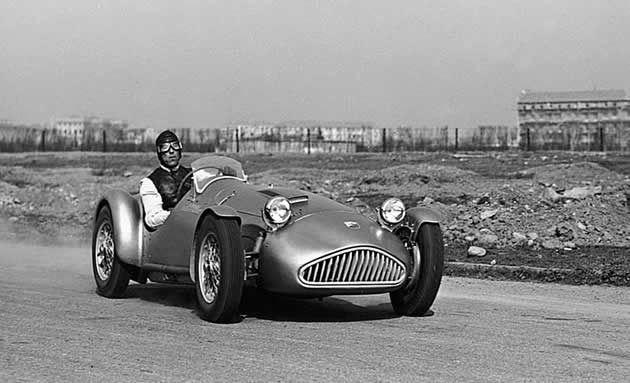
Little Cisitalia Abarth for the last victory and Cisitalia Grand Prix for the last dream
He was back behind the wheel in 1950, with his final races. He was at the Giro di Sicilia/Targa Florio (1.080 km long!) but had to retire due to the broken gear box after a few kilometers.On April 10th, he raced at Palermo-Montepellegrino hill climb, arriving 5th overall and first in his class.
His car was the Cisitalia 204 Spyder Sport elaborated by Abarth. Although he never announced his retirement from racing, this was to be his last win and his last drive, too.
Then he was seen less often, becoming increasingly isolated. His health declined and he died on August 11th, 1953, in his bed and not (as he had so frequently chanced - and what could have perhaps wished for him) at the wheel of a car. Ferdinand Porsche said then that Nuvolari was «the greatest pilot of the past, the present and the future».

